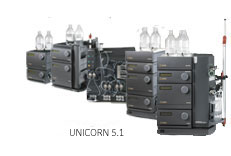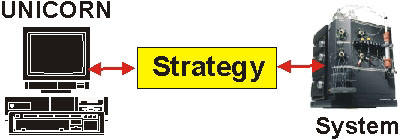

|
|
Concept definitions
|

|
|
Introduction

|
Note: The section
also lists some concepts that are described only in the User Reference
Manual. These concepts are included for reference since they may
be found in menus and dialogs that you will use while working with
this manual.
|
|
|
|
|
Alarms

|
Systems settings or method instructions specify acceptable
limits for monitor signals during a separation run.
An Alarm dialog box will
be displayed on the screen and an optional alarm can sound if a
specified limit is exceeded. The system will be paused.
Note: Refer to the
User Reference Manual for information about Alarms.
The topic is not covered in this manual.
|
|
|
|
|
Batch run

|
You can perform a Batch run of
a number of result files in the Evaluation module.
The files do not have to be open and the run operates in the background.
The procedure is useful if you want to print a number of results
with the same settings, or if you want to perform integration with
the same parameter settings on many results.
Note: Refer to the
User Reference Manual for information about Batch
runs. The topic is not covered in this manual.
|
|
|
|
|
BufferPrep

|
BufferPrep is a function
to prepare a buffer of different pH and salt concentrations online
from four stock solutions. This eliminates the need to manually
prepare new buffers every time the pH needs to be changed.
Note: BufferPrep is only available for
some ─KTAdesign systems. Refer to the User Reference Manual for
information about BufferPrep.
The topic is not covered in this manual.
|
|
|
|
|
Chromatogram

|
A chromatogram is a collection of data
represented by a number of curves that have been created during
a separation run, including UV, conductivity, pH, fraction marks
etc. The original raw data curves cannot be deleted or modified.
They can be used as a basis for evaluation procedures and subsequent
creation of new curves.
A chromatogram can also contain curves that have been created
and saved during an evaluation session.
|
|
|
|
|
Curves

|
The monitor signals from the chromatography run
are displayed graphically as curves.
|
|
|
|
|
Method

|
The program instructions for a chromatography run
are defined in a Method.
A Method is normally divided
into blocks that represent steps in the separation process.
Each block consists of a series of instructions that request specific
operations in the system.
|
|
|
|
|
MethodQueue

|
MethodQueues are used
to link several methods together,
on the same or on different systems.
Example: A MethodQueue can be set up to conduct
a CIP study of a number of columns, through a controlled series
of scouting runs.
Note: A method can
be placed in a MethodQueue if
the system is busy when the operator wants to run the method. Refer
to the User Reference Manual for information about MethodQueues. The topic is not
covered in this manual.
|
|
|
|
|
Method Wizard

|
The Method Wizard is
a user-friendly tool to create new methods. The Wizard takes the user step-by-step
through the creation process.
Method Wizards are
supplied with UNICORN installations for ─KTAdesign systems.
|
|
|
|
|
Result files

|
UNICORN creates Result files when
a method is run. The Result files contain:
Example: UV absorbance,
flow rate, conductivity, etc.
Example: Logbook
entries, calibration settings, scouting parameters, text method etc.
Example: Peak integrations,
simulated peak fractionations etc.
|
|
|
|
|
Scouting

|
Scouting is used to
repeat a series of Method runs automatically
with predetermined changes in the values for one or more Variables. A Scouting Scheme is defined as
part of the method.
Scouting is used for
optimizing chromatographic processes.
|
|
|
|
|
Strategy

|
Part of the UNICORN software is specific for the system that
it is set up to operate. The system specific part is usually referred
to as the Strategy. The Strategy defines available method
and manual instructions, system settings, run data, curves and method
templates.

Note: The examples in this guide
are generally based on the E100F400 strategy.
|
|
|
|
|
Template

|
Templates are basic
methods that can be used as a starting point for developing customized
methods. The method variables in a suitable Template is adjusted to create
a method for another application.
|
|
|
|
|
Variable

|
Values at breakpoints in the Method and
instruction parameters may be defined as Variables. Variables makes it easy to adapt
a method to a particular chromatography run.
|
|
|
|
|
Warnings

|
Systems settings or method instructions specify acceptable
limits for monitor signals during a separation run.
A Warning dialog box may
be displayed on the screen if a specified limit is exceeded. The
system will still continue to run after a Warning.
Note: Refer to the
User Reference Manual for information about Warnings.
The topic is not covered in this manual.
|
|
|
|
2005-06-15
|
|
|